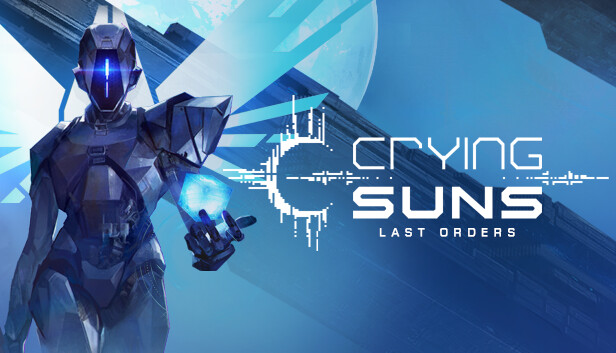Crying Suns - Digital Artbook Crack
- Crying Suns - Digital Artbook Crack Cs6
- Crying Suns - Digital Artbook Crack Windows 10
- Crying Suns - Digital Artbook Crack Torrent
- Crying Suns - Digital Artbook Crack Online
Dive deep into Crying Suns' design with the Digital Artbook. 100+ pages of lore and art showing our work on Crying Suns' universe, including exclusive key art, pixel art, but also extensive commentary from our writers about the background story, underlying power games, characters factions, and many other details behind this dystopian universe inspired by Dune and Foundation.
- In this episode, I provide an introduction to the game mechanics of Crying Suns as well as a few tips to get you off to a good start!!Follow Frost on:Discord.
- Crying Suns - Digital Artbook $9.98 Add all DLC to Cart. Reviews “Crying Suns inclusion of a well integrated story in a rogue-lite game marks it out as something of an oddity in the genre. Good design and battles that offer just enough tactical depth that even beginners can enjoy themselves.” 5/5 –.
- MangaGamer - the eroge and localization publisher bringing you popular titles like Higurashi, Rance, Kindred Spirits, euphoria, Koihime, and more!
Crying Suns keeps getting compared to FTL: Faster Than Light—and for good reason. In both games you control a lone ship against impossible odds, using your wits and relying on a bit of luck to scavenge supplies from encounters and make your way to the goal intact. FTL is a small, hyper-focused game that cuts out all of the fat and keeps the strategy the main focus. Despite thinking that’s a great design philosophy, I always wondered what it would be like to have more fat, and what would transpire if FTL was set to a grander scale. Crying Suns feels like it would be the answer to that.
Crying Suns is a strategy-based rogue-lite that takes inspiration from FTL, and some cues from Homeworld. In it, you play as a clone, Admiral Ellys Idaho, who is trying to find the answers as to why the Empire he serves collapsed and the robotic Omni servants shut down. To do this, Admiral Idaho has to lead his battleship and its fleets of ships across dangerous sectors of space.
The game starts when Admiral Idaho awakes from cloning, and is informed by the last remaining Omni robot that he just died, and is now reborn. But Idaho is reborn as a clone with no emotional memory—much like a robot, with his only directive being: seek out answers.
The story is deep, and the lore is well thought-out. The whole enterprise is set on the back of a mystery, the main question being: what or who shut down the Omnis? The Omnis are the the robot caretakers that enabled human interstellar colonies to thrive, and made space travel easier. Smarter than humans, they were so ubiquitous as to make life without them a hardship—causing billions of deaths when they shut off–and people continue to die without the Omnis and the Empire.
The mystery is interesting, and something that propelled me forward, even when the gameplay got a little repetitive. But the story itself is often told in a clumsy way—through large exposition dumps, or long conversations with prisoners or enemies that ended up making my eyes glaze over after a few minutes. As interesting as the story/lore is, it’s also extremely dense—there are lots of names, and references to ideas/technologies/factions, etc. that are hard to keep track of. Crying Suns’ story would have benefitted from more concise, bite-sized bits of storytelling.
As Admiral Idaho you control an Imperial Battleship—a massive vessel, capable of jumping from star-to-star, wielding massive weapons, and able to deploy smaller ships. You jump from star system to star system as you make your way across a sector, encountering enemies, and salvaging for tech scraps (currency), Neo-N (fuel), new ships to deploy, and more commandos to run your ground missions. As in FTL you are constantly being hunted, so you can’t take your time and explore each sector—instead, you’re forced to (pretty much) make a bee-line to the exit.
Screenshot: Crying Suns
There are only a handful of interactions in Crying Suns. You will be constantly running into other ships on your journey. When interacting with a new ship, you can usually choose to help or ignore them, depending on what their request is—that is, if they don’t outright attack you. Some of these requests are morally gray, and others intentionally played on my desire to help others to take advantage of me.
One notable example is a ship full of children I came across. These children claimed to have escaped hardship, and I offered for them to come on my ship. As it turns out, they were fanatics with bombs strapped to them. Inviting them on my ship killed a good amount of my commandos. “Fool me once…” I thought. And I was right, because when I encountered that EXACT SAME SCENARIO about six more times, I knew exactly what the deal was. And that’s one of the major problems with Crying Suns: if you’ve seen it once, you’ll likely see it over and over. There just aren’t enough encounters to make the playthrough interesting.
Sometimes you’ll encounter a planet that you can land troops on to scavenge materials. Depending on what officers you have, and what dangers your troops will likely face, you’re able to make a few choices based on probabilities. I loved the idea of sending my officers and commandos down to planets, but beyond the initial determination of probabilities, and the choice to retreat early if things are going wrong on the surface, all you do is watch an animation as your commandos do their thing.
Crying Suns isn’t only text encounters, though. At the heart of it is a Homeworld-like real-time strategy game. When two battleships meet, combat commences on a hexagonal playing field. At first, combat in Crying Suns felt extremely chaotic, but by the time I played it for a bit, it felt manageable—but still chaotic.
Screenshot: Crying Suns
Battleships consist of three major parts: the hull, the weapons, and the ship docks that deploy your fighters, drones, and frigates. All of these components can be upgraded in some way with scrap—like increasing your hull strength, or giving you an extra slot to mount a battleship weapon. The battleship weapons come in all sorts of varieties and restrictions—some weapons can’t hurt deployed ships and only battleships, while some can’t hurt battleships, and only deployed ships, etc.
Battleships can deploy all sorts of support craft, from fighters to frigates. These ships work on a rock, paper, scissors type principle. Drones do bonus damage versus frigates, frigates bonus versus fighters, and fighters bonus versus drones, etc. So deploying the proper ship to counter your enemy’s ships becomes an important part of battles.
Each battleship has compartmentalized hulls, so you can lose a few hulls and still keep kicking. These are represented by bars of health, and when destroyed, push back and stun any ship within proximity of the hull explosion.
Different types of ships can do different things, and have different strengths and weaknesses. Some drones can teleport, and sneak to your enemy’s battleship, taking chunks out of their hull before they can get a ship back over. Or you can use devastating ship weapons to take down a ship, and use your auxiliary craft defensively.
These battleship fights should be the highlight of Crying Suns—but it’s hard to feel like you’re ever on top of everything that happens. There is a pause button, for strategic decision-making during the hectic pitch of battle, but even then I felt like it wasn’t enough to keep my head above everything that was happening.
Screenshot: Crying Suns
Crying Suns makes a lot of decisions based on gameplay that are incongruous with the story going on around you, despite its attempts at tying them together. When your battleship is destroyed, you are awakened as another Admiral Idaho clone. That makes sense. But where do you keep getting all of these battleships? Why don’t you just wake up a bunch of Idahos and take a fleet of battleships? There is an in-lore answer to this, but it strikes me as odd that there is such a scarcity with materials, yet never-ending attempts to win.

As a roguelike, Crying Suns doesn’t have the usual risk-reward factor, either. Once you make your way across a sector (made of three parts), and defeat the boss of the sector, the story permanently moves forward. Even if you fail, and “start over” you’ll be starting at the last part of the story you left off. Unfortunately, that also means that after you beat a sector boss, you have to “start over” even when you’re victorious—you can’t carry your upgraded ship and build into the next phase of the story.
Crying Suns - Digital Artbook Crack Cs6
I wish there was an “iron man” mode that made you play through to completion, keeping all of your upgrades along the way. Unfortunately, Crying Suns doesn’t seem balanced for that. Which means, in reality, you’re playing the same game, with the same encounters, over and over again until you make the story go forward by beating a sector boss. Blargh. The only differences are the types of enemies (sometimes) that you’ll be running into, and the boss fight at the end of the sector. Which is just a super beefy battleship, that tests your build/luck up to that point.
It doesn’t mean Crying Suns isn’t worth checking out. If you enjoy the gameplay loop, you can keep ramping up the difficulty as you make your way through the story. And the story is certainly compelling, with an interesting mystery that might be worth your time. The art and music are all on point, and the presentation ties it all together beautifully. I love standing on the bridge of my battleship, and watching as we zoom through the star system to the next destination, seamlessly, and without loading screens.
I like Crying Suns, but there really isn’t anything to compel me to keep playing it once the mystery is uncovered. Unlike FTL, Crying Suns doesn’t trim its fat—both to its benefit and detriment. Crying Suns comes so close to greatness it hurts to say it’s just “okay.”

Crying Suns - Digital Artbook Crack Windows 10
Crying Suns is out now on Windows.

Crying Suns - Digital Artbook Crack Torrent
If you like the video game, tabletop, or other technology content that Third Coast Review has to offer, consider donating to our Patreon. We are the only publication in Chicago that regularly reviews video games, and we cover lots of local Chicago-based events and more. If you want to contribute to our coverage of Chicago’s video game scene (and more) please consider becoming a patron. Your support enables us to continue to provide this type of content and more. Patreon.com/3CR
Crying Suns - Digital Artbook Crack Online
Related
